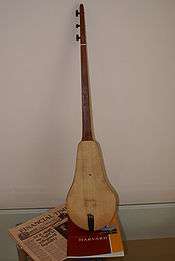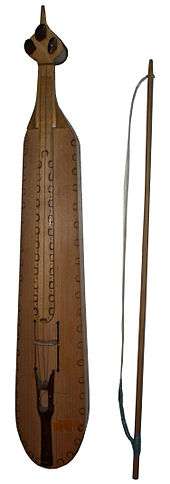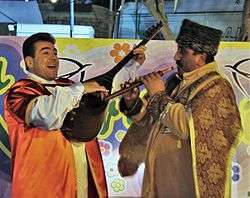Komuz
The komuz or qomuz (Kyrgyz: комуз Kyrgyz pronunciation: [qoˈmuz], Azerbaijani: Qopuz, Turkish: Kopuz) is an ancient fretless string instrument used in Central Asian music, related to certain other Turkic string instruments and the lute.[1]
 A Kyrgyz komuz | |
| String instrument | |
|---|---|
| Other names | Qomuz |
| Classification | String |
| Related instruments | |
| Other Turkic string instruments and the lute | |
It is the best-known national instrument and one of the better-known Kyrgyz national symbols. The komuz is generally made from a single piece of wood (usually apricot or juniper) and has three strings traditionally made out of gut, and often from fishing line in modern times. In the most common tunings the middle string is the highest in pitch. Virtuosos frequently play the komuz in a variety of different positions; over the shoulder, between the knees and upside down. An illustration of a komuz is featured on the reverse of the one-som note.
Playing style
The komuz can be used either as accompaniment or as a lead instrument and is used in a wide variety of musical styles including aytysh (a song competition between akyns) and the recitation of epics. It is generally played seated, held horizontally and may be strummed or plucked. One piece ("mash botoy") consists of a simple tune repeated many times, each with a new stroke, as a test of the performer’s skill and creativity. The komuz has many different tunings, and the names of the tunings correspond with various styles of music.[2]
| Kambarkan | d-a-d |
| Kerbez | e-a-e |
| Shingrama | d-a-e |
| Ongu | e-a-b |
| Ters | d-a-g |
| (unknown) | d-d'-a |
History
_b.jpg)
The word komuz is cognate to the names of other instruments in the Music of Central Asia, including the Kazakh kobyz (Uzbek qo'biz) (bowed instruments), and the Tuvan and Sakha or Yakut xomus (a jaw harp).
The oldest known komuz-like instrument dates from the 4th century although the related Azerbaijani gopuz is believed to date back to 6000 BC following an archaeological discovery of clay plates depicting gopuz players. In the 1960s American archeologists working in the Shushdagh mountains near the ancient city of Jygamish in Iranian Azerbaijan, uncovered a number of rare clay plates which dated back to around 6000 B.C. which depicted musicians at a council, holding a komuz-like instrument to their chests. The golcha gopuz was mentioned in the epic Book of Dede Korkut.[3]
The names of parts of the komuz are often allusions to body parts, particularly of horses. For example, the neck is called [mojun] "neck", the tuning pegs are called [qulɑq], or "ear"s. The Kyrgyz word кыл/qyl means "string of an instrument" or "horse's hair".
The ancient komuz generally had two or three strings. The three-stringed golcha gopuz was more popular in ancient Azerbaijan and Anatolia: the two-stringed gil gopuz or "iklyg" was used on the Altai plains, in parts of Turkmenistan and in Chinese territory inhabited by the Uyghur people.
The golcha gopuz is made from a leather covering which covered around two-thirds of the surface, and the other third is covered with thin wood along with the sound board. The total length of the instrument is 810 mm, with the body 410 mm, the width 240 mm and the height or breadth only 20 mm. The Kyrgyz: ооз комуз ([oːz qoˈmuz], literally "mouth komuz") or, alternatively, Kyrgyz: темир комуз ([temir qoˈmuz], literally "metal komuz" or "iron komuz"), is a jaw harp and as an instrument is unrelated to the komuz.
During the Soviet era the instrument fell from favour. It was derided as rudimentary and attempts were made to make it more like the Russian balalaika, notably by adding frets. After independence the komuz was again taught in music colleges, though some of the Soviet changes have remained.
In the twentieth century the late Iranian dutar player Haj Ghorban Soleimani invented a new form of the komuz which has received some popularity.[4]
Legendary origin
Various myths exist about the komuz. One tells that the hunter Kambarkan was wandering in the forest when he heard a beautiful sound. He looked for the source and found the intestine of a squirrel tied between two tree branches, which he took and fashioned into a musical instrument. It is also said that the nightingale learned to sing by copying the komuz. The name is believed to have been derived from the ancient Turkic words "gop" meaning height and "uz" meaning voice, or magic music sound.
Related instruments
Different variations of the komuz spread to several eastern European countries such as the Ukraine, Poland and Hungary during the 4th-5th century A.D, during the mass migration of the Huns into the region. There they became known with similar variations of the name. (See : kobza)
In Dagestan (a Russian republic between Chechnya and the Caspian Sea, just east of Georgia in the Caucasus) a special instrument mentioned in both the Vertkov's Atlas SSSR, and in Buchner's book, is called agach komus, or temur by the Avar people. It seems a kind of slender guitar with 3 strings, with a body (carved from one block of wood) shaped like a spade and fitted with a trident-like spike at the lower end.
The Qanbūs of the Arabian and Malay peninsulae is considered by Sachs to derive its name from the komuz.[5] The five-string kopuz is also thought to have transformed into the six-string instrument known as the sestar or seshane by 13th-century mystic Rumi. The word "sestar" is mentioned in the poems of the 14th-century poet Yunus Emre. Evliya Çelebi describes the kopuz as a smaller version of the seshane.
Media
Sources
- "The Stringed Instrument Database: Index". stringedinstrumentdatabase.aornis.com. Retrieved Aug 6, 2019.
- Solos, G. "Kirghiz Instruments and Instrumental Music", Ethnomusicology 5(1):43
- "Atlas of traditional music of Azerbaijan". Archived from the original on March 23, 2008. Retrieved Aug 6, 2019.
- Tehran Times Tuesday, January 22, 2008, Retrieved January 23, 2008
- The gambus (lutes) of the Malay world: its origins and significance in zapin Music, Larry Hilarian, Nanyang Technological University, Singapore, 06 Jul 2004
References
See also
- Music of Central Asia
- Bağlama
- Saz
- Lute
- Dutar
- Dombra
- Pandura
- Gadulka
- Gusle
- Rebab
- Kamancheh
- Cretan lira
- Kobyz
- Temir komuz
- Agiz komuzu
- Gubuz

